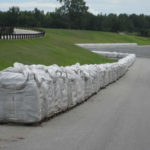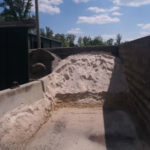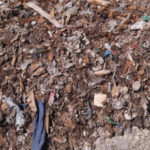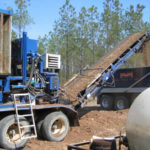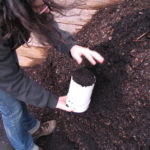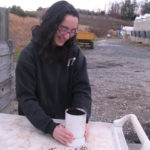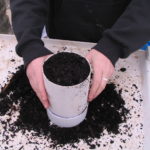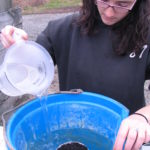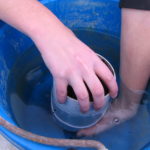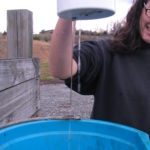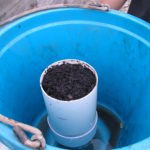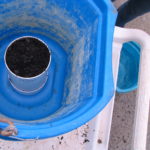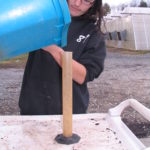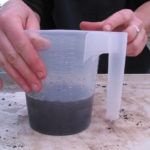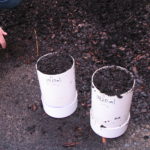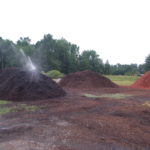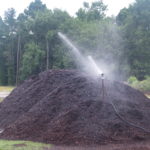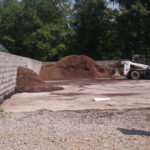Substrates
go.ncsu.edu/readext?491598
en Español / em Português
El inglés es el idioma de control de esta página. En la medida en que haya algún conflicto entre la traducción al inglés y la traducción, el inglés prevalece.
Al hacer clic en el enlace de traducción se activa un servicio de traducción gratuito para convertir la página al español. Al igual que con cualquier traducción por Internet, la conversión no es sensible al contexto y puede que no traduzca el texto en su significado original. NC State Extension no garantiza la exactitud del texto traducido. Por favor, tenga en cuenta que algunas aplicaciones y/o servicios pueden no funcionar como se espera cuando se traducen.
Português
Inglês é o idioma de controle desta página. Na medida que haja algum conflito entre o texto original em Inglês e a tradução, o Inglês prevalece.
Ao clicar no link de tradução, um serviço gratuito de tradução será ativado para converter a página para o Português. Como em qualquer tradução pela internet, a conversão não é sensivel ao contexto e pode não ocorrer a tradução para o significado orginal. O serviço de Extensão da Carolina do Norte (NC State Extension) não garante a exatidão do texto traduzido. Por favor, observe que algumas funções ou serviços podem não funcionar como esperado após a tradução.
English
English is the controlling language of this page. To the extent there is any conflict between the English text and the translation, English controls.
Clicking on the translation link activates a free translation service to convert the page to Spanish. As with any Internet translation, the conversion is not context-sensitive and may not translate the text to its original meaning. NC State Extension does not guarantee the accuracy of the translated text. Please note that some applications and/or services may not function as expected when translated.
Collapse ▲Learn about primary substrates used in production of container grown ornamentals, amendments, and how to monitor and manage inventory of substrates during production.
- Bark as a primary substrate
- Alternatives or amendments to bark
- Physical and chemical properties
- Manage Inventory
Bark as a primary substrate
Pine bark from either loblolly, short leaf, or slash pine is the primary component of substrates for container grown ornamentals in outdoor uncovered production in the southeastern U.S.
Technical Publications
- Harrelson, T. et al. 2004. How do you manage fresh versus aged pine bark? Tested growth in 100% aged or fresh bark and added nutrients to accommodate nitrogen immobilization in fresh bark. Physical properties of fresh bark, with reduced container capacity and reduced available water compared to aged bark, may have been the cause of reduced growth. Growers might manage water differently if using fresh bark solely or as an amendment. T Harrelson, SL Warren, and TE Bilderback. SNA RESEARCH CONFERENCE 49:63-66 (2004)
References
- Bilderback. Substrates for plants in big contaners. Dr. Bilderback discusses the use of pine bark for use in big containers. He provides a mini-overview of using pine bark and presents physical properties of various substrate combinations.
- Bilderback Container soils and soilless media. Dr. Bilderback provides a comprehensive review of pine bark, physical properties, chemical properties, harvesting, storing, aging an almost all other facets of using pine bark and organic substrates as media for containers
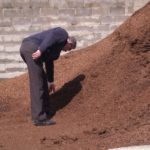 |
Pine bark supplies |
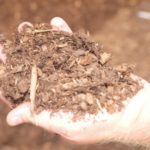 |
Pine bark based substrate |
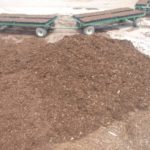 |
Raw (unmixed) pine bark supply with mixed substrate in background containers |
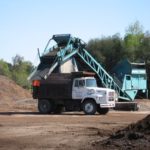 |
Substrate mixer and loader |
 |
Substrate being transported by tractor trailers |
Alternatives or amendments to bark
Technical Publications
- Witcher et al. 2012. Factors affecting early seedling development in whole pine tree substrates. Whole pine tree, either fresh or aged, did not inhibit seed germination or seedling root growth of various test species. Many substrates tested against whole pine tree. Witcher, A, EK Blythe, GB Fain, KJ Curry, and CT Pounders. 2012. SNA Research Conference 57:314-319.
- Murphy et al. 2010. Extending pine bark supplies with wholetree and clean chip residual substrates. Comprehensive study that tested growth of major crops in various percentages of pine bark and two alternative substrates. Offers good history of the two substrates and their limitations in past research. This research will provide answers to growers looking to use substrate as an alternative or addition to pine bark. Murphy, A-M, CH Gilliam, GB Fain, HA Torbert, TV Gallagher, JL Sibley, SC Marble, and AL Witcher. JEH 28:217-223 (2010).
- Murphy, A-M. 2012. Alternative substrates in production of trees in 25-gallon containers. A continuation of research to show that wood-based substrates used either extensively (100%) or as an amendment to pine bark substrates did not affect growth of common trees grown in large containers. Murphy, A-M, CH Gilliam, GB Fain, HA Torbert, TV Gallagher, JL Sibley, and SC Marble. SNA Research Conference 57:55-59.
- Wright et al Evaluation of composted municipal waste as an amendment to pine bark for use in container ornamental production. Evaluated composted household garbage (municipal solid waste compost (MSWC) as an amendment to composted pine bark for use as a growing substrate in container plant production. Studies suggested that currently replacing about one-third of pine bark with MSWC can be effectively used to grow a wide variety of container plants or flowers. Wright, AN, JL Sibley, and W Lu. Center for Applied Nursery Research.
- Croxton SD 2004. Evaluation of composted household garbage as a horticultural substrate. SL Sibley, W Lu and M Schaefer SNA Research Proceedings 49.
- Jackson et al. 2004 Cotton gin compost as a substrate component in container production of ornamental plants. Adding outputs from other industries as inputs into horticultural substrates. Composted cotton gin by-products can provide a viable alternative substrate for production of containerized ornamental crops. BE Jackson, AN Wright, and JL Sibley. SNA RESEARCH CONFERENCE 49:67-69 (2004).
- Owen JS 2004 Finding the balance: calcined clay rate effects in pine bark substrates. Good treatment design to know where on the scale of clay amendment rate growth is affected. When clay was used to amend pine bark at rates greater than 12% (by vol.) plant dry weight decreased. JS Owen, Jr, SL Warren, TE Bilderback, and JP Albano. SNA RESEARCH CONFERENCE 49:73-76 (2004).
- Jackson BE 2009 Pine tree substrate: an alternative and renewable substrate for horticultural crop production. in ACTA Hort. Brian Jackson’s early work on using de-limbed logs (no needles, but does contain small volumes of bark) as a wood-based substrate for ornamental plant production. BE Jackson and RD Wright 2009. ACTA Hort. 819:265-272.
Extension Publications
- Sherman, R. 1999. Large scale composting. Comprehensive guide to design, layout, scientific underpinning of composting, feedstock and its carbon nitrogen ratio, permitting, and testing. Rhonda Sherman, Extension Waste Management Specialist, NC State Extension. AG-593.
- Sherman, R. 2000. Community backyard composting programs. Getting started on a small scale to reuse community waste products. Rhonda Sherman, Extension Solid Waste Specialist, NC State Extension. AG-599.
- Bass et al 1992. Composting: A guide to managing organic yard wastes. Start composting in your back yard with this primer for the task. Bass, L, TE Bilderback, and MA Powell. NC State Extension. 1992. AG-467. RETIRED.
References
- Jackson BE 2009 Back to the grind. A great overview of the properties, effects on growth, and challenges to using a wood-based substrate on ornamental crops. Pine tree based substrates encourages prolific root growth in container plants. Jackson BE NMPRo 28-34.
- Jackson 2009. A suitable substrate alternative. A great history, description and vision of the use of wood-based substrates in the nursery industry. Summarizes many studies using the substrate to grow woody ornamentals. Jackson B American Nurseryman pp. 28-33 (Sept 2009).
- Bilderback et al 2007. Non-organic amendments can extend media life. Inorganic components include perlite, pumice, coarse sand, industrial clays, concrete block particles and plastics like those contained in municipal garbage. TE Bilderback, JS Owen Jr., SL Warren and JP Albano. NMPRO • Nursery Management & Production pp. 37-42.
- Bilderback TE. Fluff, stuff and any other components added to substrate. Dr Bilderback summarizes over a decade of research and investigation into using various components as amendments to pine based substrates and discusses measuring the physical properties to see if they can be used for growing ornamental plants. A semi-annotated PowerPoint as PDF.
- Bilderback and Warren. Get Physical with Fluff®. Effects of amending pine bark with garbage. Highlights research from NC State with municipal solid waste.
- Yao 2010. Whole Tree: A More Sustainable, Environmentally Friendly Substrate. Update article of a nursery using Whole Tree as a substrate. Agriculture Research Service August 2010. pp.28-29.
Physical and chemical properties
Learn the most important components to determining if a substrate is correct for use in your nursery. The physical properties, like total porosity, container capacity (water holding capacity), and air filled porosity, balance pore space for roots, air exchange and water for growth. Chemical properties, like pH and electrical conductivity, determine which nutrients are available, how tightly the substrate holds them, and if they are in high or low quantity. Moreover, when substrates are amended with organic or inorganic components, both physical and chemical properties change to affect plant growth. Make sure any new substrates are tested for these metrics to see how it might affect growth.
Technical Publications
- Bilderback et al 2005. Healthy substrates need physicals too. Dr. Bilderback and colleagues present physical property guidelines for many pine bark-based substrates with amendments. They discuss challenges to adding amendments, volumes of those amendments, and how physical properties can change from beginning to end of production in containers. TE Bilderback, SL Warren, JS Owen, Jr., and JP Albano. HortTechnology 15:747-751.
- Bilderback 2009. A Nursery Friendly Method for Measuring Air Filled Porosity of Container Substrates. The description for construction of a “home built” porometer apparatus to measure air-filled porosity (AFP) is described. This is an excellent device to monitor bark supplied between distributors, after new amendments are incorporated, or if a long time has lapsed since the last time bark was obtained from a supplier. See photos section for examples of it in use. T Bilderback Research Conference 54:212-215 (2009).
- Cooke et al 2004. Physical property measurements in container substrates: a field quantification strategy. Determining drained pore space (air space), using the simple procedure outlined here can provide useful insight into how to manage irrigation of crops having drainage or aeration problems and possibly into diagnosis of how to make changes to avoid future problems. A Cooke, T Bilderback, and M Lorscheider. SNA RESEARCH CONFERENCE 49:102-104 (2004).
- Buamsch, MG et al. 2007. Chemical and physical properties of Douglas Fir Bark relevant to production of container plants. Tested various properties of Douglas fir bark and found that properties differ less to age than to bark source. M. Gabriela Buamscha, JE Altland, DM Sullivan, DA Horneck, J Cassidy. HORTSCIENCE 42(5):1281–1286. 2007.
References
- Bilderback. Getting physical with potting mixes. Dr. Bilderback annotates a power point presentation as pdf document about measuring physical properties of substrates and how that is affected by amendments, time, and growing methods.
Manage Inventory
Learn how to manage inventory of primary substrate supplies by reading these Extension Publications.
Extension Publications
- Bilderback. Bark and roll over. Dr, Bilderback discusses media management while its on your nursery and not in containers.
- Bilderback, T. Managing container substrates. How organic potting components are stored and managed can have great effects on the chemical and physical properties of the container mix. Dr. Bilderback addresses the importance of these challenges. NC State University.
- Bilderback T., Pine bark storage and handling. An overview, provided Dr. Bilderback, of the process to maintain high quality, weed and pathogen free substrate supplies prior to potting. NC State University.
Sourcing Substrates
- Substrate, mulch and pine bark suppliers-revised version 2012. Mention of trademark, proprietary product, or vendor does not constitute a guarantee or warranty of the product by the authors, NC State University, or the Department of Horticultural Science, and does not imply its approval to the exclusion of other products and vendors that also may be suitable. To be added as a supplier e-mail avlebude@ncsu.edu and provide a name and phone number for contact.



